My wife and I recently spent a weekend in Penghu, a beautiful, stark archipelago between the main island of Taiwan and China.
Since Penghu is under KMT rule, I expected to find street signs in Magong, the capital, in some old system (e.g., MPS2 or perhaps bastardized Wade-Giles) or perhaps even Hanyu Pinyin. (Highway signs, however, are a different matter. They’re put up by the central government, which means that relatively recent ones are in Tongyong Pinyin, regardless of which party might control the area.)
This first street sign, however, is unmistakably in Tongyong Pinyin, giving “Wunsyue” (for what in Hanyu Pinyin would be “Wenxue”).
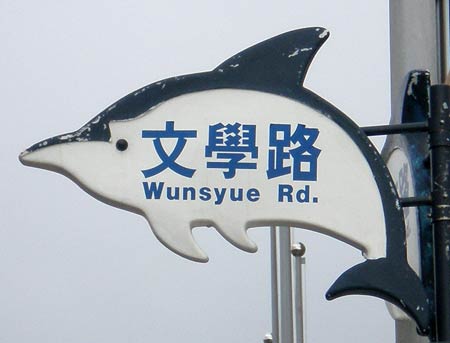
But I looked around some more and saw signs in Hanyu Pinyin, such as “Huimin” for what in Tongyong would be “Hueimin” and “Hui[‘]an” for what in Tongyong would be “Huei[-]an.”
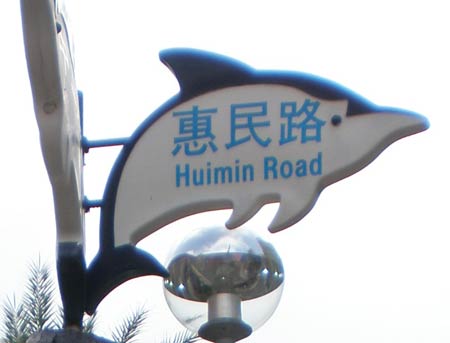
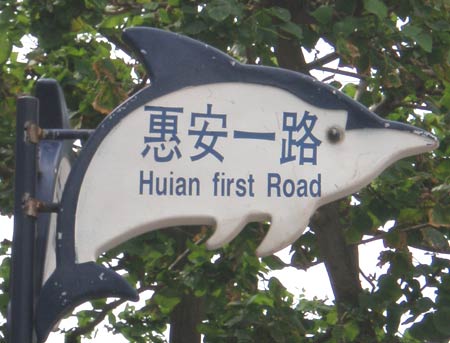
So were there some signs in Hanyu Pinyin after all? Apparently only coincidentally. The previous two hui signs were probably just a mistake, the result of Taiwan’s standard, sloppy chabuduo jiu keyi approach to signage. Here’s a sign on the same street as above; but in this case “惠” is romanized huei and not hui. (And “first” is missing, from both the Hanzi and romanization.)

Most signs were in Tongyong, such as these. (Note that Penghu, too, has a Hot Milk Road.)
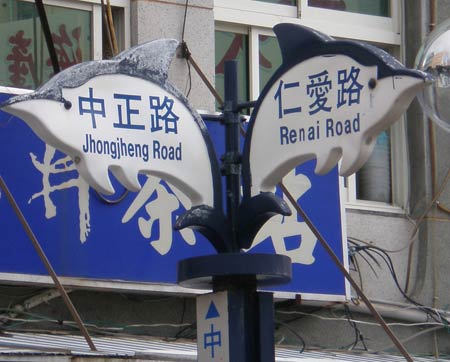
So, Tongyong after all. Well, at least they don’t have InTerCaPiTaLiZaTion … or do they?
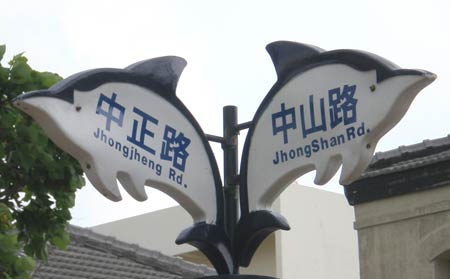
Fortunately, that sign was a one-off. I didn’t spot InTerCaPiTaLiZaTion elsewhere. Here’s another sign from the same road:
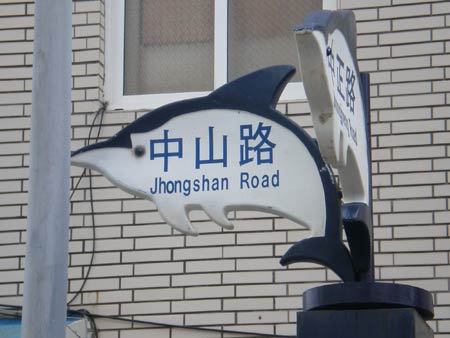
So, in short, Penghu’s street signs are in Tongyong Pinyin — but with plenty of mistakes and inconsistencies (e.g., missing apostrophes/hyphens, “first” rather than “1st”, and both “Road” and “Rd.”). It’s especially ridiculous that the KMT-administered Penghu bothered with Tongyong, especially since it was free to adopt Hanyu Pinyin. Now it’s going to have to change its signs over to Hanyu Pinyin. But some of the signs would need to be updated anyway, since many already show signs of age, with letters missing. (My guess is that Penghu put up such low-quality signs that in the annual windy season some of the letters just get blown away.)
Here’s a sign in little danger of having its writing blow away any time soon. This is what a much older Magong street sign looks like. Note that it must be read from right to left: 復國路 (Fuguo Road — “Recover Atlantis the Lost Country Road”).
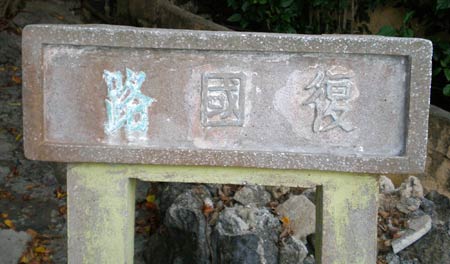
Finally, here’s something that isn’t a street sign at all. But it is nonetheless a sign of historic importance, since it’s a stela that commemorates the Ming Chinese official Shen Yourong telling the red-haired barbarians (i.e., Westerners — in this case, the Dutch) to get the hell out of Penghu. (The Dutch were told they could instead go to Taiwan, since back then China didn’t care about it in the least.) The composite photo shows both the 400-year-old stone original and a modern reproduction in wood.
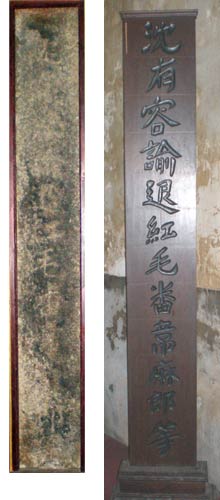
The text reads “Shěn Yǒuróng yù tuì hóngmáo fān[zi] Wéimálàng děng” (「沈有容諭退紅毛番韋麻郎等」): “Shen Yourong orders the red-haired foreigners under [Dutch commander] Wybrand van Warwijck to withdraw.”

What a strange set of signs. It only adds confusion. And the dolphins! I don’t know, not my taste. But excellent work nonetheless. I think more pressure needs to be put on public officials to harmonize romanization in Taiwan. Heck at this point, I’d even applaud a uniform application of Tongyong (perish the thought…). Still beats Hong Kong’s strange romanization of Cantonese though.
On the off chance that anyone else knows, I was looking through Michael Turton’s blog and at the last photo of this entry, there is a sign that I am not getting.
http://michaelturton.blogspot.com/2008/11/protest-pictures.html
Is this a Taiwanese rendition of We are Taiwanese? I know from Cantonese that ? (hai) is the ‘to be’ verb. Is this the same for Taiwanese Minnan?
Thanks to anyone who knows…
The sign, which is indeed in Taiwanese, reads “??????!” Yes, the ? (pronounced xì in Mandarin and pretty close to that in Taiwanese) works as the verb to be here. So according to my wife — I don’t know Taiwanese — there are two ways to read this:
1. “Your father is Taiwanese!” [Literal.]
2. “I’m Taiwanese!” [Assertive, proud, and crude. “I’m fuckin’ Taiwanese! You gotta problem with that?” might be one way to put it into English.]
> the ? (pronounced xì in Mandarin and pretty close to that in Taiwanese)
????????????? They blew it. The correct character is just a plain old ? here? If they were writing ??? then ? would be OK, but they aren’t.
Interesting post. The officials are definitely sloppy with their signage… I saw that in Taipei as well for the streets I lived near.
As far as the “?”, since there is not really (as far as I know) a standardized way of writing Taiwanese, they are using the “?” character to represent the sound of the word “to be” (“?”) in Taiwanese. So they didn’t exactly blow it… One way to write colloquial Taiwanese is to use close homophones from Mandarin.
???????????????
The character ? is the original character here.
Mandarin and Taiwanese use ? for the copula.
Hakka uses ?.
Face it, ? is what Taiwanese is using.
???????? all fit with the same origin as what is in Mandarin.
Yes, some words have the same origin and share the original character between Mandarin and Taiwanese.
Most Taiwanese sentences have one or two words which one cannot find a
100% valid character for, e.g., ?? which we could write ?? or ??
etc., but the ? is certified genuine, by me.
????
I meant ????
Maybe I should stop playing expert.
Anyways, I sat in on a lot of ??? historical phonology classes.
But that was before I forgot my gym shoes somewhere.